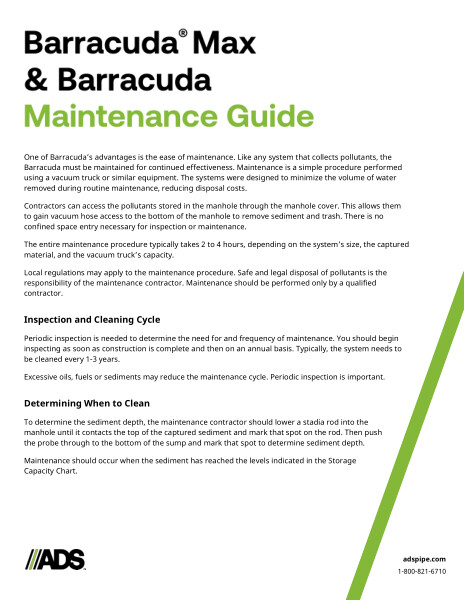Barracuda Max & Barracuda Maintenance Guide
Filename:
Barracuda Max & Barracuda Maintenance Guide.pdf

This document is the Barracuda Max & Barracuda Maintenance Guide. It describes maintenance, inspection, cleaning and Barracuda storage capabilities.
One of Barracuda’s advantages is the ease of maintenance. Like any system that collects pollutants, the Barracuda must be maintained for continued effectiveness. Maintenance is a simple procedure performed using a vacuum truck or similar equipment. The systems were designed to minimize the volume of water removed during routine maintenance, reducing disposal costs.
Contractors can access the pollutants stored in the manhole through the manhole cover. This allows them to gain vacuum hose access to the bottom of the manhole to remove sediment and trash. There is no confined space entry necessary for inspection or maintenance. The entire maintenance procedure typically takes 2 to 4 hours, depending on the system’s size, the captured material, and the vacuum truck’s capacity. Local regulations may apply to the maintenance procedure. Safe and legal disposal of pollutants is the responsibility of the maintenance contractor. Maintenance should be performed only by a qualified contractor.
The inspection and Cleaning Cycle is needed to determine the need for and frequency of maintenance. You should begin inspecting as soon as construction is complete and then on an annual basis. Typically, the system needs to be cleaned every 1-3 years. Excessive oils, fuels or sediments may reduce the maintenance cycle. Periodic inspection is important. To determine when to clean the sediment depth, the maintenance contractor should lower a stadia rod into the manhole until it contacts the top of the captured sediment and mark that spot on the rod. Then push the probe through to the bottom of the sump and mark that spot to determine sediment depth.
Maintenance should occur when the sediment has reached the levels indicated in the storage chart. The chart showing model number, manhole diameter, total system volume, treatment chamber capacity, standard sediment capacity and NJDEP sediment capacity and corresponding values is included.
Maintenance instructions with figure showing bowl, access cylinder, vac truck hose, sump and sediment is shown.
